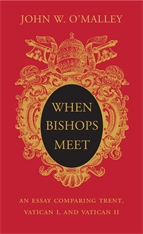O’Malley, John W. When Bishops Meet: An Essay Comparing Trent, Vatican I, and Vatican II. Cambridge: Harvard Belknap, 2019, pp. 240, $24.95, hardback.
John W. O’Malley, professor of theology at Georgetown University, has established himself as one of the most learned and thoughtful historians of the great councils of post-Luther Roman Catholicism. Having previously published separate monographs on the Council of Trent and on the First and Second Vatican Councils, this slim volume represents a capstone to his work in this area, offering a reflection upon how modern Catholicism has developed since the Reformation with particular focus on its conciliar actions.
The book is arranged thematically rather than chronologically, with each chapter comparing the Councils in terms of a particular topic. Part One raises three basic questions: What do Councils do? Does Church teaching change? Finally, who is in charge? Part Two looks at the categories of people involved: popes and their curia, theologians, laity, and The Other—meaning non-Roman bodies, Orthodox, Protestant, and non-Christian. Part Three then asks what difference the Councils made and whether there will be another one.
Protestant readers will find much that is of interest here. O’Malley is adept at explaining the different dynamics of the three Councils in their historical context. Protestant readers will find the book to be very helpful in this regard as it gently but firmly puts to death numerous popular misconceptions. We learn, for example, that Protestants were invited to be involved at Trent and reform—real, theological reform—was at least for a time a possibility; that the dogma of papal infallibility did not go uncontested at Vatican I and, in its approved form, is a far more restricted idea than is generally thought; and, finally, that Vatican II was a much more diffuse and complicated affair than either later Catholic conservatives or liberals have sought to make it. Perhaps most interesting has been the rise to prominence at and since these gatherings of theologians (as opposed to bishops) as a real force within the Church and, after Vatican II, of the laity itself as an influential body. What the book does so well is show that the concept of a council, at least in terms of how it transacts its business, has varied over time. Rome—and many of her Protestant critics—may believe that she herself is unchanged and unchanging but the history of these three Councils indicates otherwise, at least in terms of who exerts influence and how they exert it.
Despite these strengths, at times O’Malley glosses over key facets of Roman church history. For example, on pp. 57-58 he claims that bishops were starting to defer to Rome by the third century and that this became more pronounced once Christianity was the dominant religious force in the Empire. Yet on p. 7 he states that Rome and the West played mainly marginal roles in the first seven ecumenical councils, a position he reiterates in modified form on p. 59, where he says they played roles ranging from important to marginal. Is this a case of O’Malley’s love of his church pulling him one way, the historical facts pulling him in another? When we remember that ancient prelates in Baghdad considered Constantinople to be the western bishop, historical and geographical relativity would seem critical in assessing Rome’s claims to universal supremacy.
Another questionable claim appears on p. 103. O’Malley maintains that it was only with the advent of universities in the thirteenth century that theologians emerged as an influential category of teachers separated from the office of bishop. Although it is perhaps pedantic to note, universities did not emerge in a vacuum but from (among other things) a tradition of independent teachers of theology (Peter Abelard being only the most famous). In addition, the whole monastic tradition of an earlier era had produced numerous theologians who were not bishops.
As he looks to the present and the future in the final section, O’Malley is optimistic. It is interesting that he praises the 2015 encyclical, Laudato Si, as a great example of post-Vatican II social concern. More traditional Catholics have identified it as a Trojan Horse by which the pope is making room within the church’s teaching and practice for elements of the sexual revolution. Benedict XVI only merits a mention for his role at Vatican II, when the later conservative pope worked in alliance with the very unconservative Karl Rahner. His papacy is neglected completely—which is a shame, given that Ratzinger/Benedict might be one of the most theologically adept men ever to have been Bishop of Rome. As to whether there will be another council, O’Malley is hopeful that there will a Vatican III, albeit the now vast number of bishops would make logistics difficult and agreement on almost anything harder to reach.
This book is a fitting capstone to O’Malley’s four-part series on the great Councils of Roman Catholicism. Readers, including laypeople and students, will find their understanding both of the councils and Catholicism enhanced. And Protestants may be compelled to think about how their churches have responded to challenges over the years and how well-equipped they are to address those of the present and the future.
Carl R. Trueman
Grove City College




